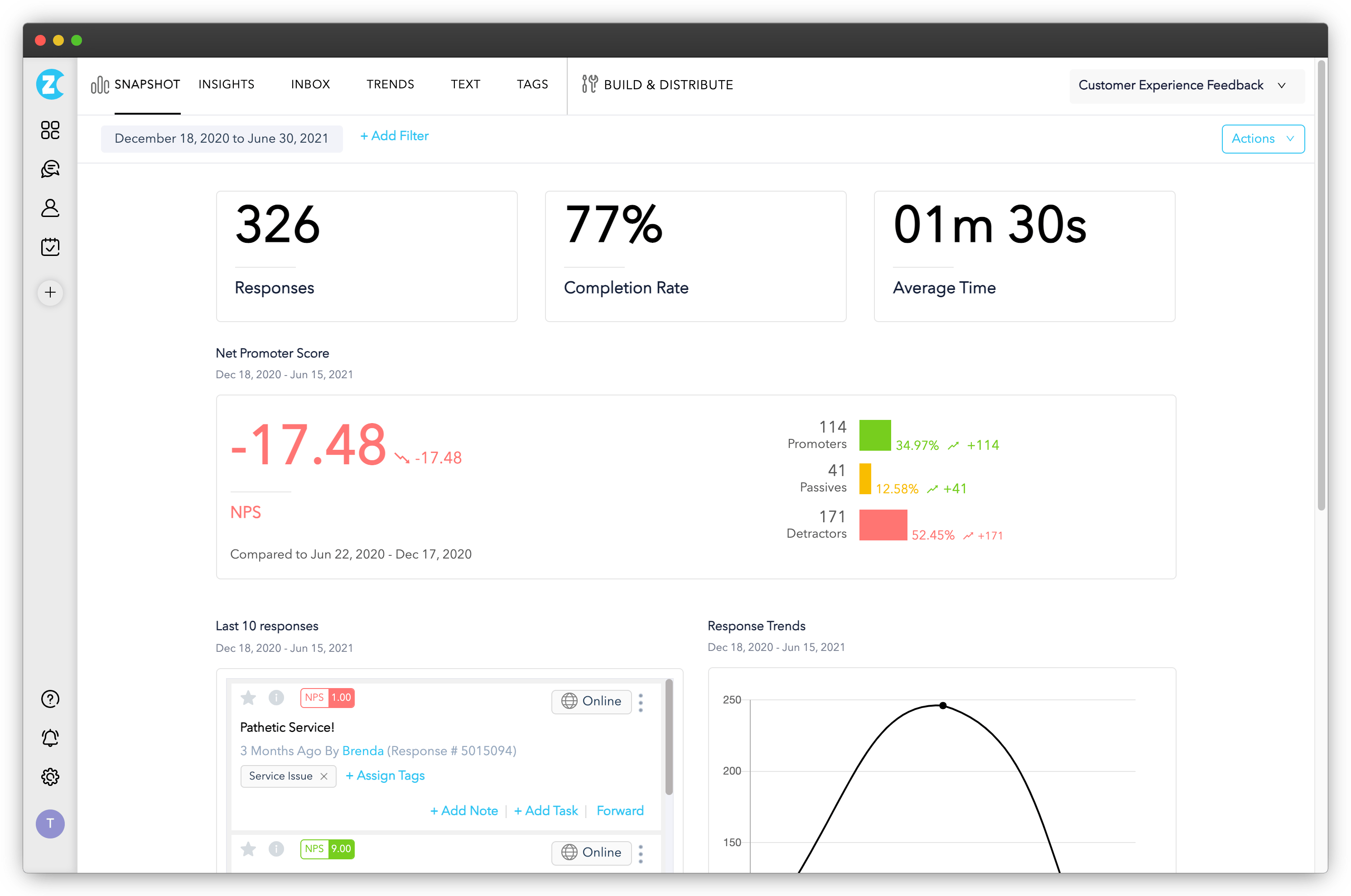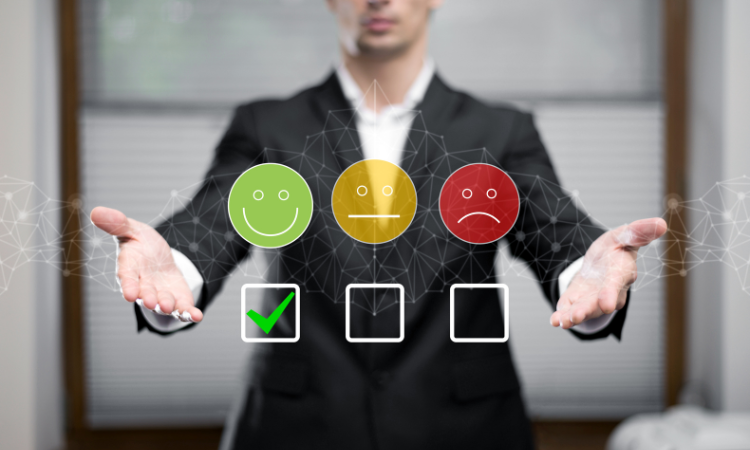Companies that improved their customer experience (CX) improved their sales revenue by 2 to 7 percent. And, their profitability by 1-2 percent.
It's no surprise, that customer experience will strongly impact your bottom line.
Consider the tale of a major retailer that revamped its entire CX strategy and saw its customer satisfaction scores soar by 30% within a year. This isn't just a singular success story; it's a testament to the transformative power of a well-executed customer experience program.

Superior customer experience is no longer a luxury but a necessity for staying competitive. As organizations navigate this dynamic landscape of changing customer expectations, understanding and acting towards improving customer experience becomes paramount, not just for retaining customers but for driving sustainable growth.
But how can corporations with hundreds and thousands of customers, clients, or consumers achieve this feat of customer experience?
By creating memorable experiences at every point the customer interacts with your business!
Ready to take the leap towards a holistic customer experience?
In this article, we'll explore customer experience in detail, discussing its significance for your business, how you can create an effective CX strategy, and methods that can improve the overall customer journey.
TL;DR
- Customer experience is the customer's perception or sentiments while interacting with your business. It includes all direct and indirect touchpoints in the customer journey.
- CX impacts the bottom line of your business. Focusing on customer experience can improve ROI, reduce churn, boost loyalty, enhance cost efficiency, and much more.
- Developing an effective customer experience requires building a CX vision and aligning the company culture with it.
- Measuring CX is imperative to understand the impact of your customer experience initiatives and iterating accordingly. Utilizing CX metrics like Net Promoter Score (NPS), Customer Effort Score (CES), and Customer Satisfaction (CSAT), identifying reasons for customer churn, performing sentiment analysis, etc., can help you measure customer experience.
- To improve customer experience, you can leverage customer experience surveys, automate workflows, utilize advanced reporting and analytics, capture in-moment feedback, and segment users.
- With Zonka Feedback, you can easily create CX surveys, share via different communication channels, and analyze results to take action and close the feedback loop. Schedule a demo to explore its various features.
Elevate Customer Experience With AI-Powered Insights
Collect real-time, in-moment feedback at all touchpoints in the customer journey and leverage feedback insights to transform the customer experience.

What is Customer Experience?
Customer experience (CX) is the overall perception or feelings that a customer has while interacting with a brand throughout the customer journey. It is the core of the relationship your business shares with its customers.
Typically, you would think customer experience ends at having a well-organized store with attentive staff or an intuitive website or mobile app. However, it encompasses all touchpoints, from the initial awareness stage to post-purchase interactions.
Everything, from your brand and frontline people to the products, price, systems, and channels, contributes to customer experience.
This includes every interaction, whether it is an exposure to your ad, a visit to your store, browsing of your website, using your product, or a message/call to support, every exchange adds something to the relationship between a business and its customer.
The key is to do everything you can to keep your customer needs and expectations on priority. To ensure your customers view those experiences in the utmost light.
A positive customer experience aims to meet or exceed customer expectations, boosting brand loyalty, advocacy, and repeat business. It involves understanding customer needs, providing seamless and consistent interactions, resolving issues promptly, and continuously improving based on customer feedback.
Typically, people limit customer experience to the interactions they have with the frontline or service team- attentive store staff, customer support, etc. Basically, they connect it with people, representing the business.
However, that's where they confuse customer service with customer experience.
CX goes beyond the frontline.
It navigates into every possible trench of your customer journey, not just the reactive part where the customer reaches out for support.
How is Customer Experience Different From Customer Service (CX vs. CS)
Even though both customer service and customer experience aim to ensure satisfaction, they represent broader and distinct aspects of managing customer relations.
Customer service refers to the personalized care provided to customers through various channels like email surveys, in-person interactions, or online support, addressing their immediate needs and concerns.
It's a crucial part of customer experience management but focuses mainly on solving problems and answering queries, whether through staff interactions or automated tools like chatbots.
On the other hand, customer experience (CX) is much broader and covers the entire customer journey.
It covers not just customer service but also everything influencing how customers perceive a brand. This includes marketing, product design, brand values, aesthetics, and even external factors like reviews and media coverage.

Let's understand the difference better with an example.
An enterprise, MegaCorp, uses a software solution from a vendor, TechPro. When MegaCorp encounters issues, its IT team contacts TechPro's support multiple times, struggling to get clear answers. Each interaction is transactional, focused solely on resolving the immediate issue. There’s no proactive communication or understanding of MegaCorp's broader needs.
However, this is a reactive approach that assists a customer when they've experienced an issue.
Now, here's how a holistic customer experience approach changes the perspective.
TechPro has transformed its approach to focus on customer experience. They now maintain a dedicated CX team that ensures a holistic understanding of MegaCorp's journey. Before MegaCorp even installs the software, TechPro's customer success manager initiates two-way communication, learning about MegaCorp's specific goals and challenges. They provide a tailored onboarding process, including training and resources to prevent common issues. Throughout the relationship, TechPro engages in proactive service, offering regular check-ins and updates to MegaCorp, ensuring the solution continues to meet their evolving needs.
Under the new, holistic approach, MegaCorp experiences a seamless implementation process with TechPro.
- They receive proactive support
- Feel that their feedback is valued and acted upon.
This relationship-driven approach ensures MegaCorp's satisfaction and fosters long-term loyalty, as opposed to the frustration and disjointed interactions experienced in the old way.
Importance of Customer Experience
The importance of customer experience can be understood from the fact that 86% of consumers express their willingness to pay more for a superior customer experience. Moreover, about 64% are inclined to recommend a brand if they have had a positive experience.
Imagine a large bank with a fragmented customer experience.
Their online banking platform is modern and user-friendly (pre-purchase). However, calling customer service requires navigating a confusing phone menu and long wait times (purchase). Once connected, representatives often struggle to access complete customer history, leading to frustrating back-and-forth conversations.
This disjointed customer experience harms the banks in more ways than one.
- Reduced Customer Satisfaction: Customers become frustrated and may switch banks due to the hassle of simple tasks.
- Increased Operational Costs: Long wait times and inefficient processes require additional staff and resources.
- Missed Opportunities: Dissatisfied customers are less likely to consider additional products like loans or investment services.
While the bank understood the importance of customer experience, they did not take the holistic approach.
A modern online platform was just one piece of the puzzle.
Had they addressed all touchpoints in the customer journey, from pre-purchase to post-purchase, the bank could have created a seamless and positive experience which you've led to:
1. Positively Impact your Revenue and Sales
A better customer experience directly results in better sales. When customers have positive interactions and experiences with your brand, they're more likely to help increase sales through the following:
- Repeat Purchases: Satisfied customers are more likely to make repeat purchases. A positive experience encourages customers to return to the brand for future needs.
- Customer Advocacy: Happy customers often become advocates for the brand, sharing their positive experiences with friends, family, and colleagues. These word-of-mouth recommendations can lead to new customers who trust the opinions of existing customers, thus driving sales.
- Increased Spending: By fostering loyalty and repeat purchases, CX helps increase customer lifetime value (CLTV). This metric represents the total revenue a customer generates throughout their relationship with your business.
- Loyalty Programs: Effective CX can integrate well with loyalty programs, encouraging customers to spend more to earn rewards.
- Product Development: Insights from customer feedback can lead to improvements and innovations in products or services, making them more appealing and increasing sales.
- Upselling and Cross-Selling: Happy customers are more receptive to upselling and cross-selling opportunities. If they trust your brand and value your products or services, they're more likely to consider additional offerings.
A strong focus on CX creates a positive customer journey, fostering trust, loyalty, and ultimately leading to increased sales
2. Enhances Cost Efficiency
Delivering a streamlined and enjoyable experience contributes to cost reduction across various fronts. This includes reducing expenses related to customer acquisition, retaining existing customers, and marketing your brand.
You must keep in mind that while a positive customer experience can increase brand loyalty among customers and advocacy, poor customer experience results in additional costs, as efforts are required to rectify the dissatisfaction and retain customers.
3. Increases Customer Loyalty and Retention
Successful businesses often share a common trait—loyal customers who are exceptionally satisfied with their experience. It's noteworthy that approximately 65% of a company's business stems from existing customers alone.
The customer retention rate affects the profit potential of the business. If your customer retention rate is high, it will also augment revenue and the profit rate.
Usually, customers want quality-grade products/services at an optimal price, but if you provide the same and the extra value, they are willing to pay more for the same products/services. This, in turn, enhances both your conversion and profit rate.
Happy customers transform into brand advocates, actively promoting a product or service through positive word-of-mouth thereby increasing new customer acquisition and over time loyalty.
4. Reduces Customer Churn
Customer Churn Rate is not the happiest measure but a crucial metric to evaluate the growing business. Simply put, it refers to the percentage of customers that stopped using your product/service during a certain period.
For instance, if you start your quarter with 600 customers and end at 580, your churn rate is 5% because you lost 5% of your customers.
A brand that consistently delivers exceptional customer experience facilitates enduring customer relationships; thus, reducing churn. Enhanced customer experience increases customer lifetime value and significantly reduces the likelihood of them switching to competitors.
By creating a strong emotional connection and loyalty, companies offering superior experiences form a tough barrier against churn. Moreover, loyal customers tend to be more forgiving of occasional service hiccups and are more likely to remain committed to a brand, contributing to its long-term success.
5. Provides Crucial Customer and Market Insights
A strong focus on customer experience (CX) involves actively listening to customer feedback. This feedback provides enterprises with valuable insights into customer preferences, pain points, and market trends. Understanding what customers like or dislike, and what they need, allows businesses to make informed decisions.
Customer feedback offers real-time data that can be used to refine strategies, improve products, and tailor services to better meet customer demands.
This continuous loop of feedback and adjustment ensures that the company stays relevant and competitive.
By systematically gathering and analyzing customer insights, you gain a deeper understanding of their needs and expectations. This empowers you to continuously improve your offerings and craft a CX that builds loyalty, drives sales, and positions your business for long-term success.
Understanding CX Better With Customer Experience Examples and Use Cases
Customers tend to come back when they feel heard and their expectations are fulfilled.
This includes understanding what customers expect and then acting on their feedback using customer feedback tools and making necessary improvements. A lot of businesses across various industry verticals have excelled at customer experience. And can be a great source of inspiration for your CX strategy.
Let us look at some of the examples of customer experience across different industries.
1. Banking (BFSI) Customer Experience
Banking was considered to be a very stodgy, old industry. Even as simple a task as opening an account required filling so many forms, visits to the retail branches, getting signatures from different departments, and whatnot.
Cut to today, you can do it in seconds.
How did this happen?
They analyzed customer behavior, gathered insights from feedback across every touchpoint, and created more defined customer journeys with connected omnichannel experiences.
From undefined customer journeys, disjointed data sources, and process/product-based workflows, they gradually shifted towards understanding customer expectations and evolved, with technology playing a huge part in it.
From mandatory in-branch visits, they shifted to ATMs, phone banking, and online banking platforms in the early 2000s. However, personalization was still limited and experience still remained impersonal.
Today, we can see personalization and omnichannel experience playing a crucial role in baking customer experience. Mobile apps have become the dominant channel, offering on-the-go banking with features like mobile deposits and bill pay.
CX became a strategic priority, with banks investing in data analytics to understand customer behavior and tailor products and services.
Examples of Customer Experience in Banking
Capital One: Capital One, a leading bank in the US, taking note of the increasing use of voice assistants for banking, launched Alexa-enabled functionalities in the mobile banking app. It would connect with a chatbot and answer questions, thus improving their experience.
Simpl: Simpl integrated their platform with Zonka Feedback for feedback management and transformed their CX strategy. They reached out to and gathered feedback from 6 lakh+ users and were able to pinpoint pain points, customer concerns, and areas where their services fell short of expectations. By implementing improvements based on feedback, they were able to enhance customer satisfaction and loyalty.
2. Healthcare Customer Experience
According to a recent survey conducted by Harvard Business Review Analytic Services, 60% of 115 healthcare industry executives have identified enhancing CX as their top business priority, surpassing all other priorities.
However, this wasn't the case always.
For years, the healthcare sector struggled with outdated technology and a disjointed ecosystem. Doctors were the ultimate authority figure, patients had less access to medical information, and scheduling appointments over the phone was a hassle. Patients navigated a complex maze of paperwork, scheduling challenges, and impersonal interactions.
Today, consumers expect a more personalized experience across every touchpoint and put a high value on convenience, quality, support, and communication.
Today, healthcare executives have an array of data coming in from electronic health records (EHR), information reported via patient feedback systems and survey apps (via voice, email, or text), public health data (e.g., social determinants of health), lab and pharmacy data. They're using data and technology as catalysts for a digital transformation, revolving the experience around patients.
A large majority are even using AI to understand patient needs, improve satisfaction, and ensure exceptional care by uncovering the "why" behind patient feedback.
Examples of Customer Experience in Healthcare
- Mayo Clinic: Mayo Clinic Platform utilizes data from remote patient monitoring, sensors, and Internet-of-Things (IoT) devices placed in patients' homes. This data is continuously analyzed by advanced AI survey tools and systems to monitor patient health in real-time. If any anomalies or health concerns are detected, the system alerts healthcare professionals to take immediate action, ensuring timely and proactive care, delivered directly in patients' homes.
- Intuitive Health: Intuitive Health, by combining urgent care and emergency room model, seeks to improve the patient experience by providing convenient access to care and reducing wait times.
- Cleveland Clinic: Cleveland Clinic places a strong emphasis on patient experience. They have implemented a comprehensive patient feedback system to continuously improve care quality. The MyChart app allows patients to easily schedule appointments, access medical records, and communicate with their healthcare providers. Additionally, they offer virtual consultations, making healthcare more accessible and convenient, especially during the COVID-19 pandemic.
3. Retail Customer Experience
Remember the days of fighting crowds at Walmart on Black Friday, the only way to score those deep discounts? Retail has come a long way from those limited-choice, impersonal experiences. Back then, giants like Walmart thrived on brand recognition and a vast selection under one roof.
The internet changed everything.
Suddenly, customers had access to a world of products at their fingertips. Comparing prices became a cakewalk, forcing even retail giants to adapt.
Delivering omnichannel experiences enables retail conglomerates a comeback at a time when Amazon became a challenge.
But outstanding customer experience isn't just about online bells and whistles.
Large retail conglomerates are also investing in making the physical store experience more engaging and efficient. Interactive displays, self-checkout kiosks, and even in-store pickup points for online orders all contribute to a smoother, more convenient shopping trip.
They are actively utilizing technology, collecting customer feedback using the right retail survey questions, and modernizing their own systems like retail mobile apps, AI-retail chatbots, etc. They know that integration of insights and actionable metrics is the only way to enhance customer experience.
Customers crave personalization! Stores that offer unique experiences see more repeat business. One survey highlights this, showing 88% of online shoppers prefer personalized sites.
An amalgamation between physical stores and online shopping- "Phygital retail" is also on the rise. It would allow one to use QR codes on products revealing details, or use a digital catalog to buy online for in-store pickup.
To truly excel, a seamless customer experience across all channels is key. Retail stores can let customers follow up through their preferred method, be it social media, website, etc. An FAQ page empowers customers with immediate answers, while feedback forms help you improve.
Finally, a strategic omnichannel messaging strategy ensures you reach the right audience, boosting brand awareness and sales.
Examples of Customer Experience in Retail
- Walmart: Walmart was one of the first few to undergo the retail renaissance. It created its one comprehensive online shopping portal where customers could browse their extensive online selection, check local store availability for pickup, or even order online with in-store delivery options. They've been piloting drone delivery in select areas, allowing customers to receive everyday essentials directly to their doorsteps within a short timeframe. They're even offering a GenAI powered shopping assistant in their app.
- Target: Known for its trendy finds, Target now allows its shoppers to create a digital shopping list, scan product barcodes in-store for reviews and recommendations, and even use their app to pay for purchases, skipping checkout lines altogether. IT even aced at personalization, offering recommendations based on customers' recent online browsing habits.
4. Customer Experience in Hospitality
Experience is the most powerful differentiation in the hospitality industry. And it has undergone a significant transformation in customer experience (CX) over the years!
Initially, services were generic, but modern hospitality emphasizes personalization, with customized experiences tailored to individual preferences.
The integration of technology has streamlined processes, from online booking systems to mobile apps for seamless check-ins and digital concierge services.
Enhanced amenities, such as luxury spa services and high-end dining, have become standard. Continuous customer feedback drives service improvements. Players in the industry have started asking hotel survey questions to capture feedback on guest experience, identify gaps, get in-depth insights, and deliver a better experience.
Data analytics allow hotels to personalize experiences with targeted recommendations, room preferences based on past stays, and local recommendations.
Hospitality goes beyond the stay. Seamless booking, contactless check-in, and mobile room keys enhance convenience.
Mobile payments, self-service options, and voice-controlled amenities like smart thermostats are becoming commonplace.
Examples of Customer Experience in Hospitality
- Marriott International: Marriott International exemplifies this evolution. They have incorporated advanced technology with their Marriott Bonvoy app, offering seamless booking, mobile check-ins, and personalized experiences. They continuously enhance their amenities and maintain high standards of hygiene and sustainability, reflecting modern hospitality trends.
- Ritz-Carlton: Ritz-Carlton is renowned for its exceptional customer experience. They empower their employees to create personalized experiences for guests, going above and beyond to meet their needs. For example, if a guest mentions a preference or need, the staff ensures it is addressed during their stay and even remembered for future visits. This level of personalized service creates a memorable and luxurious experience, fostering strong customer loyalty.
What is a Good or Positive Customer Experience?
A good customer experience (CX) is all about leaving the customer feeling satisfied, valued, and wanting to return for more. Here's what makes a positive experience, along with practical examples:
However, ensuring a good customer experience isn't about a one-size-fits-all approach. Each business and its customers are distinct.
Yet, there are several common principles that underscore a positive customer experience. These include:
1. You are Meeting & Exceeding Expectations
This is sure way to enhance customer experience and leave them feeling satisfied. You can check whether the product/service meets the advertised quality? Was it delivered/completed on time? Did the company address any issues promptly and efficiently?
Example: You order a pizza online with a promised delivery time of 30 minutes. It arrives hot and fresh within 25 minutes. (Meeting expectations) The delivery person even throws in a free order of dipping sauce. (Exceeding expectations)
2. Your Support & Service Is Exceptional
Train support staff to prioritize customer satisfaction, empower them to handle queries effectively, and gather post-resolution feedback for insights and improvement. Evaluate staff friendliness, attentiveness, and problem-solving approach.
Example: You call customer service with a question about a product. The representative listens patiently, addresses their concerns directly, and offers a personalized solution, they even follow up to close the feedback loop.
3. You've Mastered Personalizing Experience
Tailor interactions and solutions to meet the specific needs and preferences of each enterprise client. Use data analytics to understand and anticipate their requirements. Remember their past behavior and offer targeted recommendations based on your history.
Example: Delivering a birthday email offering a personalized discount or free drink.
4. You Take a Proactive Approach Than Reactive
Today's customer experience is about being proactive rather than reactive. Provide proactive assistance by identifying potential issues before they arise and offering timely solutions. Regular check-ins and updates can prevent problems and build trust.
Example: Predictive maintenance for products or services, preventing breakdowns before they happen.
5. You Can Anticipate Your Customers Needs Beforehand
Collect feedback using customer feedback software and data to understand customer pain points and preferences. Anticipating their needs before they arise can help deliver an exceptional experience. It can help measure customer satisfaction, identify pain points, and even uncover crucial insights even from unstructured data using AI feedback analysis.
Example: Analyzing negative feedback patterns in food delivery at a large conglomerate, you are able to identify pain points like bad taste or low quantify being set and work on the same to eliminate churn.
6. You've Identified & Leveraged the Power of Omnichannel
Customers navigate your brand across various touchpoints - website, social media, physical stores. Ensure a consistent experience at each one. Information, processes, and customer service should be seamless, regardless of the channel they use.
Other ways to deliver a positive customer experience
Apart from the ones discussed above, there are few more ways in which one deliver a positive or a good customer experience.
Here are some of them:
- Embrace the Customer Journey: Move beyond individual transactions and map the entire customer journey. Understand your customers' needs, expectations, and pain points at every stage of their interaction with your brand. This holistic view allows you to identify areas for improvement and personalize touchpoints accordingly.
- Harness the Power of Data: Leverage customer data analytics to personalize interactions. This can involve recommending products or services based on past purchases, remembering communication preferences (email vs. phone), or offering loyalty program benefits that align with customer behavior.
- Invest in Employee Empowerment: Empower your employees to deliver exceptional service. Provide comprehensive training on customer needs, product knowledge, and effective communication. Equip them with the tools and resources they need to resolve issues efficiently and go the extra mile for the customer.
- Embrace Self-Service Options: Provide customers with convenient self-service options. Utilize online knowledge bases, FAQs, or chatbots to empower them to find answers to common questions or resolve minor issues independently. This frees up your customer service team to handle more complex inquiries.
- Feedback is a Gift: Actively solicit customer feedback through surveys, social media monitoring, or post-interaction emails. Analyze this feedback to identify areas for improvement and demonstrate that you value their input. Respond to both positive and negative feedback promptly and professionally.
What Makes a Bad Customer Experience?
A bad customer experience leaves the customer feeling frustrated, angry, and unlikely to do business with you again.
While there can be numerous contributing factors, a bad customer experience can stem from various factors including:
1. Lack of Personalization
- Problem: Clients face long wait times for support, leading to operational disruptions.
- Example: A critical support ticket is submitted but goes unanswered for days, causing frustration.
- Solution: Implement a robust support system with defined SLAs (Service Level Agreements) that guarantee prompt responses. Use automated acknowledgments and provide estimated resolution times.
2. Slow Response Times
- Problem: Clients face long wait times for support, leading to operational disruptions.
- Example: A critical support ticket is submitted but goes unanswered for days, causing frustration.
- Solution: Implement a robust support system with defined SLAs (Service Level Agreements) that guarantee prompt responses. Use automated acknowledgments and provide estimated resolution times.
3. Poor Communication
- Problem: Clients are left in the dark about project progress, leading to confusion and frustration.
- Example: Clients are not kept informed about milestones or delays, hindering their ability to effectively plan.
- Solution: Establish clear communication channels with regular updates. Utilize project management tools to share progress, address issues promptly, and keep clients informed.
4. Inefficient Problem Resolution
- Problem: Repeated issues go unresolved, requiring clients to contact support multiple times.
- Example: A service continues to malfunction after multiple support requests, wasting the client's time.
- Solution: Provide thorough training for support staff to empower them to resolve issues effectively in the first interaction. Implement a feedback loop to ensure problems are permanently fixed and don't recur.
5. Complicated Onboarding Processes
- Problem: New clients struggle with a cumbersome onboarding process, delaying service utilization.
- Example: A new client encounters a confusing onboarding process, hindering their ability to get started quickly.
- Solution: Simplify and streamline the onboarding process. Provide clear instructions, user-friendly tools, and dedicated onboarding specialists for personalized guidance.
6. Ignoring Feedback
- Problem: Client feedback is not acknowledged or acted upon, leading to feelings of being undervalued.
- Example: A client submits detailed feedback that is never addressed, making them feel unheard.
- Solution: Actively solicit client feedback and demonstrate how their input has led to improvements. Utilize surveys, follow-up calls, and dedicated feedback tools to gather valuable insights.
7. Inadequate Post-Sale Support
- Problem: Once a sale is made, clients find it difficult to get ongoing support, feeling abandoned.
- Example: After the initial purchase, the client finds it challenging to access support, hindering their ability to maximize the product's value.
- Solution: Establish a dedicated post-sale support team and schedule regular follow-ups to ensure client satisfaction. Offer ongoing training sessions, provide access to updates, and maintain a channel for continued assistance.
Improving Customer Experience: Strategy & Best Practices
A customer experience strategy is like a roadmap designed to ensure customers have great interactions every time they connect with your brand. It involves understanding what customers need and want and making sure that everyone in the company works in tandem to achieve the business goal. This strategy helps in attracting and retaining customers by providing top-notch experiences.
Here are some suggestions to help shape your overall approach to creating customer experience strategies.
Strategies to Create and Improve Customer Experience
A customer experience strategy is like a roadmap designed to ensure customers have great interactions every time they connect with your company. It involves understanding what customers need and want and making sure that everyone in the company works in tandem to achieve the business goal. This strategy helps in attracting and retaining customers by providing top-notch experiences.
When it comes to creating a customer experience strategy, the key is to create a culture centered on people and experiences.
Here is a step-by-step of how you can create a culture where improving customer experience is not just a task but a continuous process.
Step 1. Set your CX Goal or Aspiration
The first step is crucial- you need to start with your senior executives, even the CEO. As CX is a cross-functional issue, every team, department, and decision-maker needs to align with the same CX goal.
Remember, CX is a company-wide effort, so everyone needs to be on the same page.
You also need to break down departmental silos and foster cross-functional teamwork. Customers don't care about internal structures, who's in finance, who's handling design, or who's managing operations. They expect a seamless journey and won't need to get their issue resolved, fast.
Step 2: Strengthen Your CX Data
Next, empower your data.
Unify customer data, operational data, and financial data from across departments. This holistic view lets you understand the customer journey and identify improvement opportunities.
Invest in the right skills – human-centered design to understand customer needs, and data science to analyze data and gain valuable insights. Build a team of "CX athletes" – adaptable, high-potential employees who can work across departments to tackle CX challenges.
Step 3:. Leverage CX Surveys
Employing surveys like NPS surveys, CSAT surveys, or CES surveys helps in understanding customer sentiment. Starbucks, for instance, utilizes feedback surveys to refine store experiences, menu offerings, and loyalty programs. These surveys provide crucial insights into the satisfaction levels of customers and specific pain points, facilitating targeted improvements.
You can tailor surveys to specific touchpoints or segments to get focused insights. For example, a targeted CSAT survey after an online purchase gauges customer satisfaction levels regarding the shopping experience, pinpointing areas for website optimization or checkout process enhancements.
Step 4: Create Feedback Loops
Encourage customers to share their thoughts and experiences through various digital channels, such as online surveys, feedback forms, or social media platforms. By actively collecting customer feedback and valuing user opinions, you gain invaluable insights into their needs and preferences.
Additionally, customer feedback often uncovers pain points, highlighting areas where your business can improve. Respond promptly to feedback, acknowledge their input, and take actionable steps to address their concerns. This engagement not only shows customers that their opinions matter but also demonstrates your commitment to their satisfaction, fostering a stronger and more loyal customer base.
Step 5: Creating a Customer Journey Map
Building a customer journey map involves visualizing and understanding every touchpoint a customer encounters when interacting with your brand. This map outlines the entire customer experience, from initial awareness to post-purchase engagement, helping identify pain points, moments of delight, and opportunities for improvement.
By mapping out the customer's journey, you can gain an understanding of customer needs, emotions, and motivations at each stage.
.png?width=1000&height=500&name=Customer%20Journey%20Map%20(2).png)
This, in turn, facilitates the implementation of targeted strategies to enhance these touchpoints, ensuring a seamless and satisfying customer experience throughout their journey with your brand.
Step 6: Cater Every Touchpoint for Omnichannel Experience
Ensure a consistent and smooth experience for customers across all touchpoints. Whether they're interacting with your website, or mobile app, or visiting your physical store, maintaining a unified brand message and service quality is key. For example, you can offer the same discounts or promotions both online and in-store.
Step 7. Automate Workflows
Automating workflows significantly enhances customer experience by streamlining processes, reducing response times, and ensuring consistency.
For instance, automated email responses acknowledging customer inquiries or purchases assure prompt acknowledgment, instilling confidence in customers. These workflows also enable personalized follow-ups, such as post-purchase emails with relevant recommendations, promoting customer engagement.
Moreover, automation eliminates manual errors and ensures tasks are executed seamlessly, allowing customer service teams to focus on complex issues, ultimately improving efficiency and delivering a smoother, more responsive experience for customers throughout their journey.
Step 8: Measure ROI
Measuring ROI in customer experience aligns initiatives with tangible business outcomes. It quantifies the impact of CX improvements on metrics like revenue or retention, guiding resource allocation. This data-driven approach informs strategic decisions, optimizing investments toward high-impact CX initiatives.
ROI measurement completes the feedback loop, enabling iterative enhancements and fostering a customer-centric culture. It ensures that efforts are directed effectively, demonstrating the value of CX improvements in driving business success and elevating customer experiences.
Step 9: Make CX a Priority
Finally, make CX a strategic priority, not a quick fix. Leadership needs to view it as a long-term investment that fuels business success.
Remember, happy employees lead to happy customers. Invest in employee experience to ensure your team is empowered to deliver exceptional service.
Best Practices to Improve Customer Experience
Customer experience has evolved over the years.
With customer expectations evolving, there is a shift in how brands interact with their customers.
To keep up with the same, one need to follow the trends and best practices to ensure they are offering everything that their customer expects and more.
1. Personalize User Experience
Personalizing the user experience involves adapting interactions to the customer's preferred contact method and offering tailored product recommendations based on past behavior. Too much automation or outreach that isn't personalized can lead to a consumer experience that is impersonal, disconnected, or generic.
By leveraging customer data to comprehend preferences and habits, you can swiftly address customer needs, offering targeted support and a more personalized experience.
For example, you can send customized product suggestions that align with past purchases. Or, browsing history can enhance the shopping journey's relevance and overall customer experience.
Similarly, personalizing emails by referring to customers by name adds a human touch and promotes more engaging interaction and positive client experience. 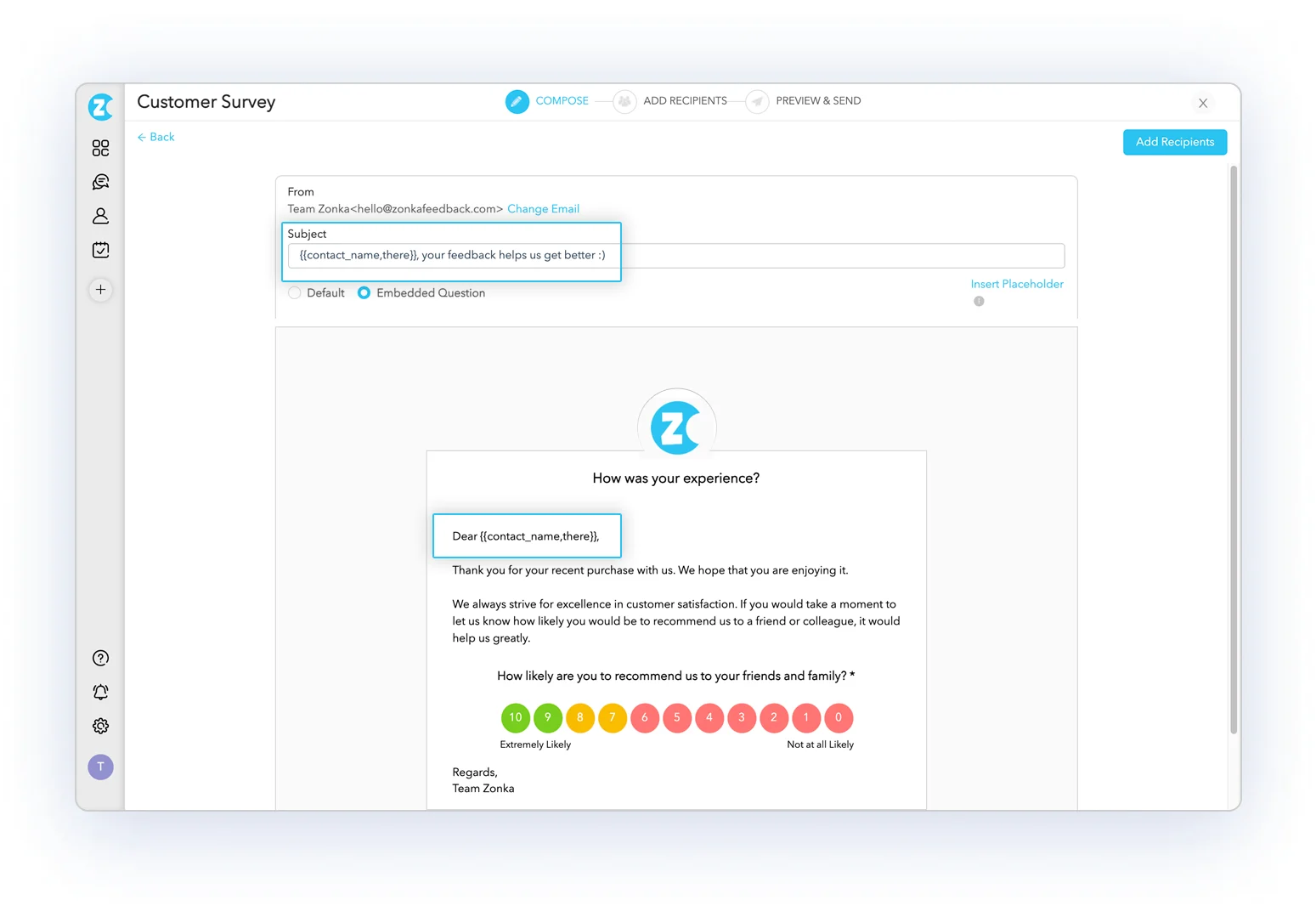
2. Utilize AI Effectively
Leveraging AI involves using chatbots and virtual assistants to streamline routine tasks, offer real-time aid, and enhance overall efficiency. These technologies analyze vast customer data, like purchase history, browsing behavior, or customers' interactions in the past, enabling personalized recommendations and targeted marketing.
Incorporate AI-driven customer experience solutions like chatbots for instant customer support. These bots can answer common queries or guide customers through simple tasks, providing timely assistance 24/7.
Our software also has AI feedback analysis that helps you identify customer emotions, sentiments, intent, and much more to make the most of their unstructured feedback data. You don't just know what customers say about your brand but also the feelings and the reason behind it.
This aspect of Zonka Feedback can be used effectively to gather customer data across all touchpoints, trigger workflows to take action based on what customer are feeling, and close the feedback loop.
3. Offer Proactive Experiences
Creating a proactive customer experience means anticipating needs before they're expressed. By offering solutions preemptively, like providing guides to local attractions upon booking in the hospitality sector, you can enhance customer journeys.
Proactive gestures, such as targeted information and support before inquiries, cultivate customer centricity, ensuring customers feel supported throughout their experience.
4. Utilize Advanced Reporting & Analytics
To understand user expectations, it is essential that you analyze customer behavior and preferences. Leveraging advanced reporting and analytics revolutionizes the customer experience by exploring behavioral patterns and preferences through a spectrum of reports. You can utilize an survey software that enables you to take:
-
Snapshot Report: Provides a quick overview of essential metrics and KPIs at a glance.
-
Insights Report: Offers in-depth analysis and detailed findings derived from data or customer interaction.
-
Trends Report: Uncovers evolving patterns and changes in customer behavior or market trends over time.
-
Tags Report: Categorizes and organizes data or customer interactions based on specific tags or labels for easy reference and analysis.
-
Text Analytics: Text analysis tools mine unstructured data from feedback, reviews, or social media to extract sentiments and key themes.
5. Segment Users for Personalization
Segmenting customers based on behavior or preferences allows for tailored experiences. Spotify, for example, leverages user behavior to curate personalized playlists, enhancing user engagement and satisfaction.
Personalization based on segmentation creates a deeper connection with customers, catering to their unique needs. By using an online survey tool, you can conduct surveys and send them to a specific audience. For instance, you can employ segmentation to send an NPS survey exclusively to individuals who haven't responded in the past month and to those who have given score between 0 to 8.
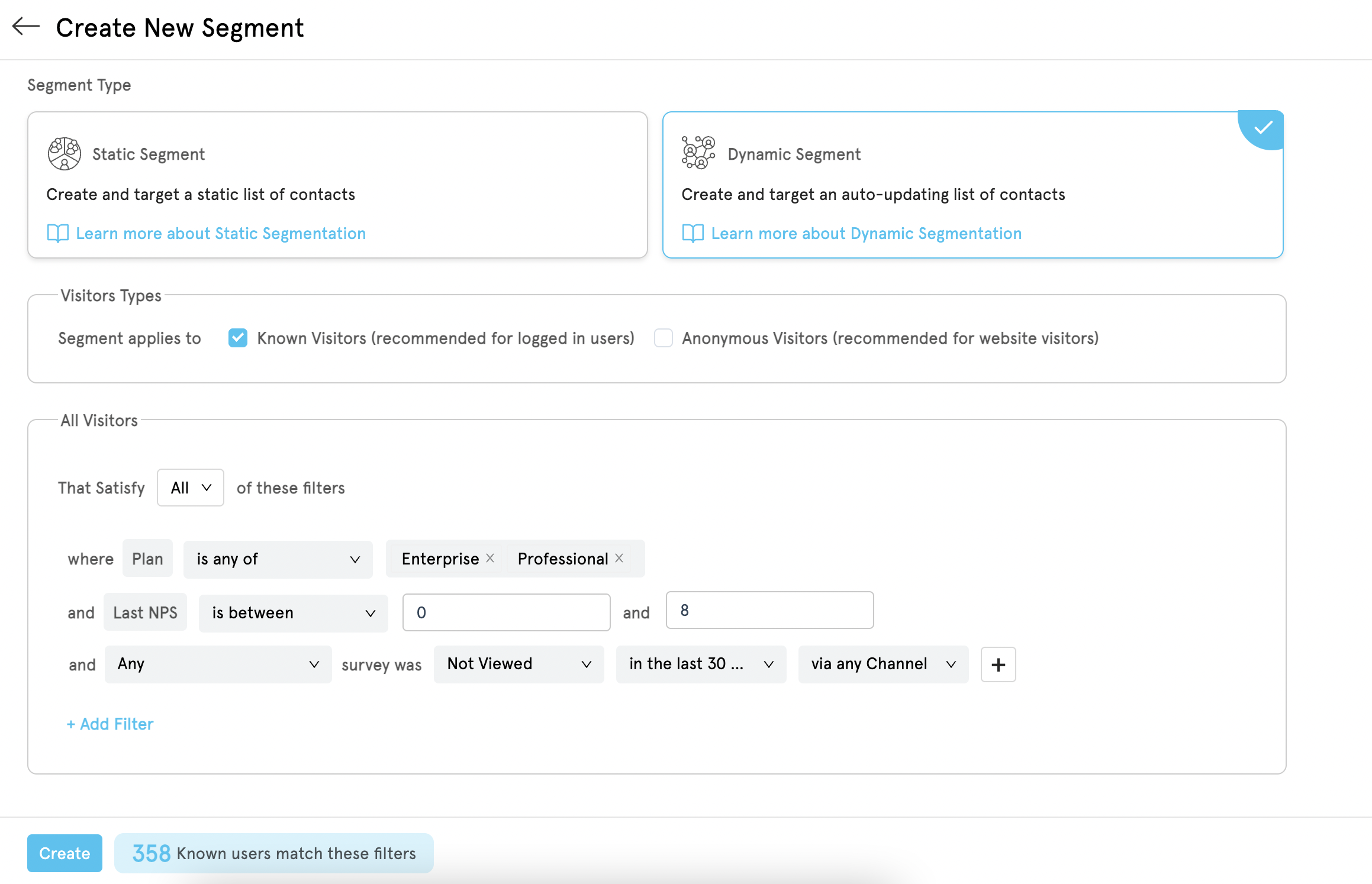
6. Leverage Multichannel Customer Satisfaction Strategy
A multichannel customer satisfaction strategy maximizes customer engagement by offering diverse interaction avenues. It integrates various platforms—online, in-store, and social media—ensuring consistent service delivery. For instance, Apple provides a seamless experience across its website, stores, and customer support, ensuring a consistent brand experience.
A cohesive multichannel strategy ensures customers receive consistent service and support, irrespective of the platform they choose to engage with. This unified approach across multiple channels ensures a consistent brand experience, enhancing overall customer experience and promoting loyalty.
How to Measure and Analyze Customer Experience?
Or should I think about what kind of use cases or what kind of questions I need to ask and then start getting the data? Because we also hear from our clients that collecting data is a problem and processing data is another problem. Finding the right people to do all this work is another problem. So, what would you do if you were an executive on this one? And how can you measure the value or the return on investment on this one?
Once you have your customer experience strategy in place, you need to check if it is effective. By measuring your CX programs, you can track progress and determine if they are working effectively.
Let us look at some of the methods that can help you measure customer experience and get a holistic understanding of it.
1. Utilize CX Metrics
Utilizing quantifiable CX metrics through voice of customer tools enables ongoing tracking of its progression or regression. Here are some most popular key customer experience metrics widely utilized by CX professionals and customer relationship management (CRM) teams to monitor and evaluate customer experience across various stages of the customer journey.
-
Net Promoter Score: NPS or the Net Promoter Score is a customer loyalty score derived from asking customers how likely customers are to recommend your product/service to others. It's calculated by subtracting the percentage of detractors from the percentage of promoters.
-
Customer Effort Score: CES or the Customer Effort Score evaluates the ease of a customer's experience with a product/service. It measures the effort customers need to exert to accomplish a task or resolve an issue.
-
Customer Satisfaction Score: CSAT or Customer Satisfaction Score helps to measure customer satisfaction with a specific interaction or experience.
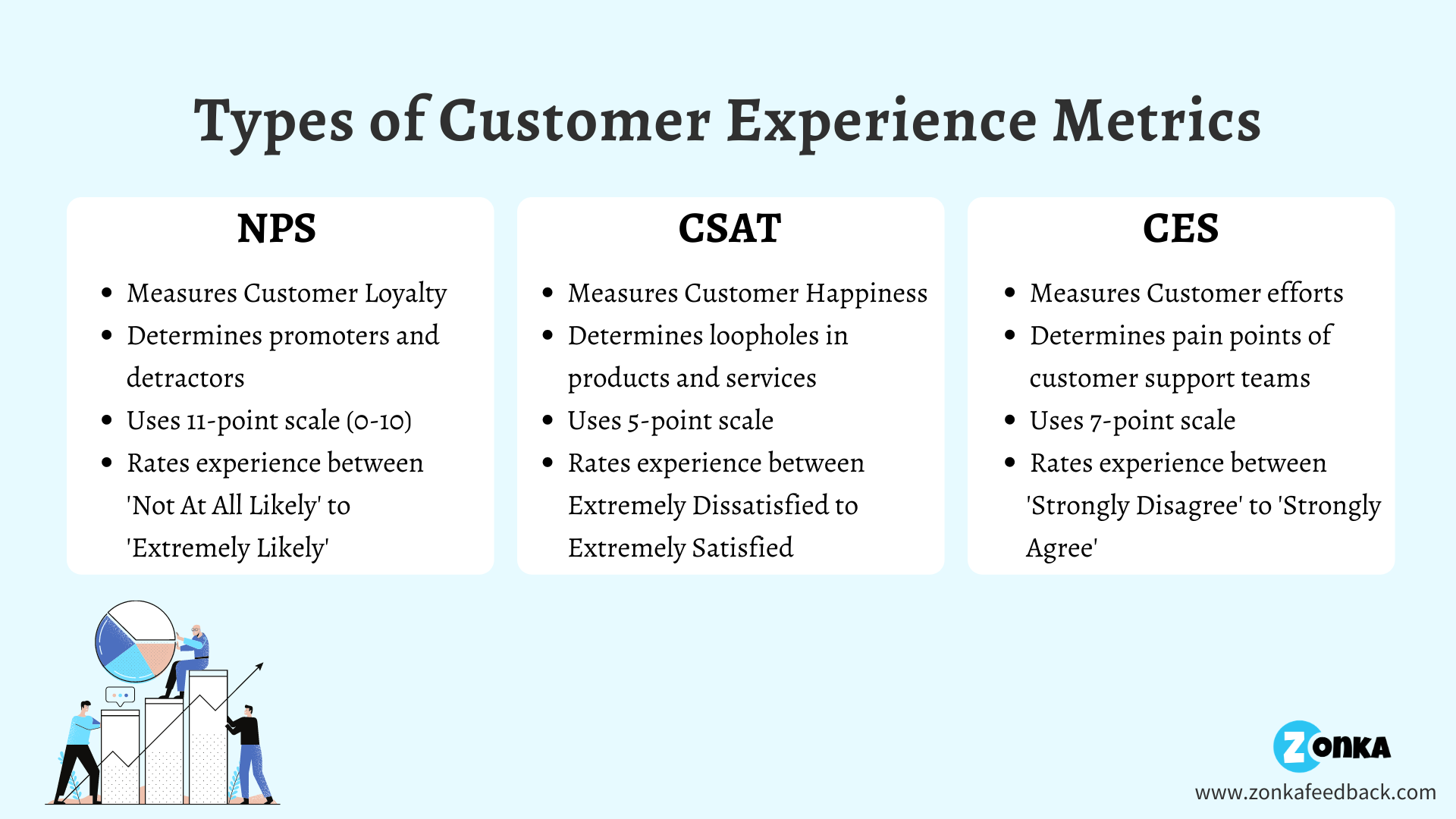
You can leverage these CX metrics to gain a comprehensive view of customer sentiment, enabling targeted improvements in specific areas. For example, analyzing CES might reveal pain points where customers face undue difficulty in completing tasks, such as a convoluted checkout process in an e-commerce platform. This insight prompts focused efforts to streamline processes, simplifying the checkout steps and reducing customer effort.
2. Identify Reasons for Churned Customers
Analyzing the reasons behind churn offers valuable insights into the effectiveness of your customer experience strategies. By examining why customers churn, you can gain an understanding of pain points or issues that negatively impact the customer journey.
For instance, through exit surveys, discovering that a substantial churn results from unresolved support issues highlights the need for improved customer service or streamlined issue resolution processes.
Moreover, churn analysis helps track customer trends in attrition rates, indicating whether the customer experience is improving or declining over time. If the churn rate rises, it signals potential issues that need immediate attention to prevent further customer departure.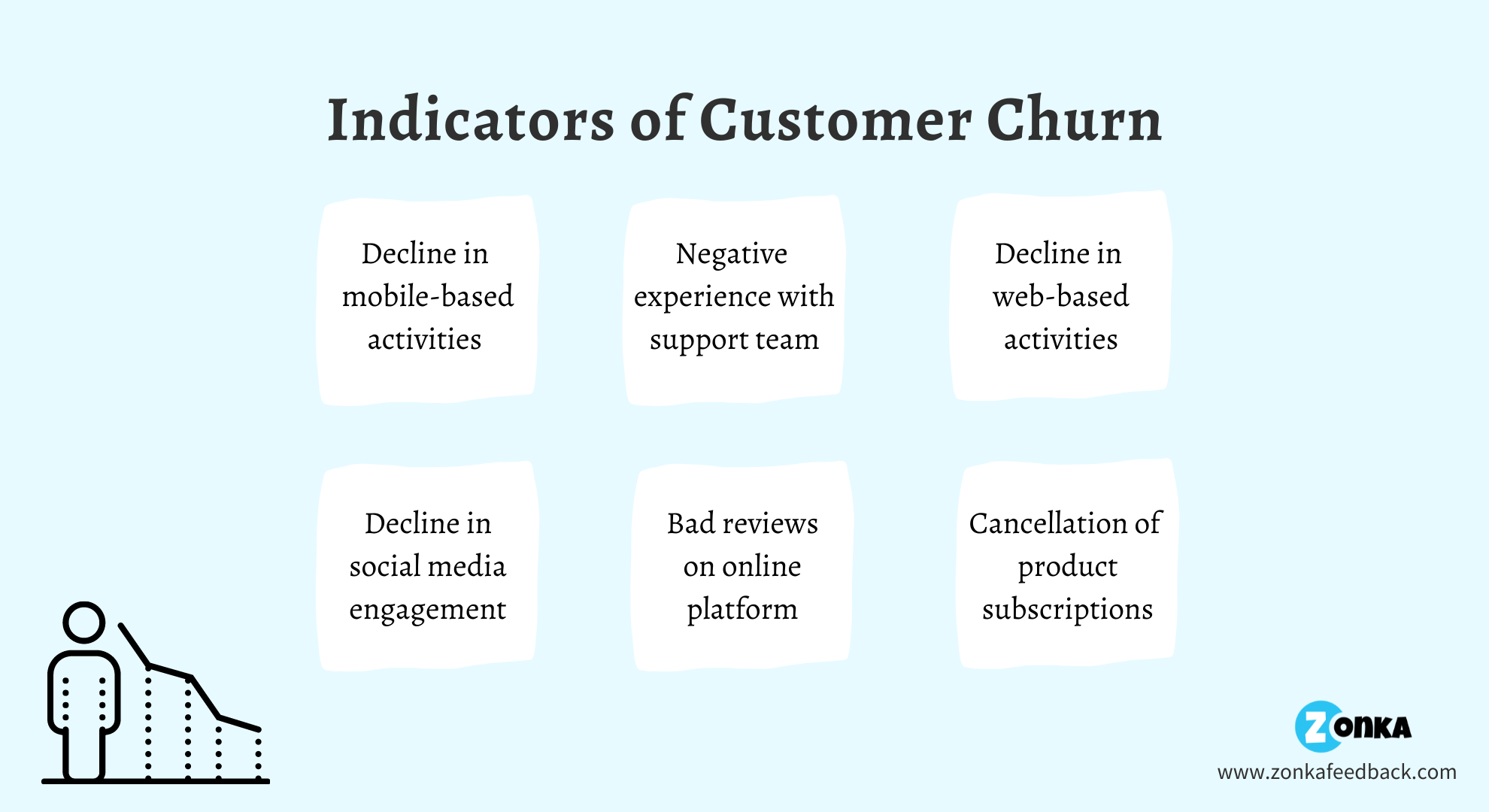
3. Perform Sentiment Analysis
Performing sentiment analysis aids in gauging customer experience by examining emotions and opinions within feedback, online reviews, and social media mentions. This method employs natural language processing to categorize sentiments as positive, negative, or neutral.
A sentiment analysis tool unveils underlying reasons for customer satisfaction or dissatisfaction, identifying key pain points in the customer journey. Insights that you gather can guide improvements, benchmark against competitors, and drive personalized strategies, promoting better experiences aligned with customer preferences.
Based on the sentiments, emotions, intent, or urgency, you can easily create workflows and trigger follow-up emails, send out apologies for customers with negative sentiments, route feedback to the respective team, and much more.
4. Analyze Time to Resolution (TTR)
Analyzing Time to Resolution (TTR) significantly measures customer experience by assessing how promptly customer issues are resolved. It acts as a barometer for customer service efficiency—a shorter TTR often indicates higher satisfaction.
Addressing prolonged TTRs helps streamline processes, ensuring prompt issue resolution, and ultimately fostering positive customer experiences aligned with quick problem-solving.
5. Conduct Comparative Tests
Performing comparative tests, like A/B experiments, compares different aspects of the customer journey or interfaces. This method evaluates variations to pinpoint which gives better results. By testing multiple approaches, such as website layouts, mobile apps designs or service processes, you can gather practical data to make informed decisions.
Identifying the more effective option empowers you to implement changes that noticeably enhance the overall customer experience, ensuring strategies are based on proven success rather than assumptions.
Conclusion
Customer experience is the cornerstone of business success, and as a company, your aim should be to offer the best customer experience. Enhancing customer experience directly impacts profitability through increased sales, customer retention, and positive word-of-mouth referrals. Furthermore, a better reputation attracts new customers while solidifying trust, driving long-term success and sustained growth for your company.
By utilizing a powerful customer experience software tool like Zonka Feedback, you can streamline data collection, analyze customer feedback, and implement tailored strategies that resonate with customer preferences. With features like customizable survey templates, user segmentation, workflow automation, and multi-channel feedback collection, you can easily enhance customer experiences and cement your brand's reputation for exceptional service.
Schedule a demo and get started to experience how it works for your business!

